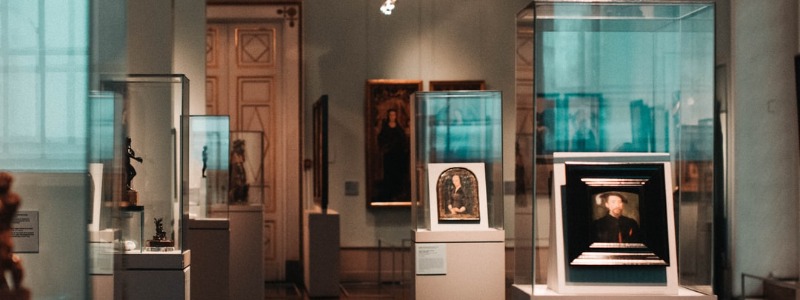Even to the untrained eye, it’s clear that Houston is a city that loves its museums. While this city evidences a true appreciation for keeping history within reach with destinations like the Houston Maritime Museum, the Museum of Natural Science, and the Houston Holocaust Museum, it also shows off a love for contemporary additions to the world. The fascinating ArtCar Museum (a must for those with a love for the unconventional), the stunning Bayou Bend Collection and Gardens, and the Contemporary Art Museum are just a few of the intriguing destinations that captivate both locals and travelers on a regular basis.
Bayou Bend Collection and Gardens
Contents
6003 Memorial Dr, Houston, TX 77007
Bayou Bend, the restored mansion of Houston philanthropist Ima Hogg, is the decorative arts wing of MFAH. It contains one of the finest collections of American furniture, paintings, glass, and textiles from 1620 to 1870. Another home, Rienzi, was donated to MFAH in 1991 by Houston philanthropists Harris Masterson III and his wife, Carroll Sterling Masterson. Rienzi, which holds the Southwest’s most important collection of European decorative art, showcases an important collection of 18th- and 19th-century art and antiques.
The Menil Collection
1515 Sul Ross, Houston TX, 77006
The Menil Collection—a local treasure, global destination, and one of the top free attractions in Houston—opened to the public in June 1987 to house the art collection of philanthropists John and Dominique de Menil. Widely considered one of the greatest of the twentieth century, the collection consists of more than 16,000 works dating from the Paleolithic era to the present day.
Although historically vast, it uniquely resists the conventional museum model of the encyclopedia. Instead, within the four areas that largely define the collection—Antiquity, Byzantine and Medieval, Tribal, and Twentieth-Century Art (with a concentration in Surrealism)—one finds a selective—and even wonderfully eccentric—approach to collecting and displaying art.
Other museums near The Menil Collection:
Cy Twombly Gallery showcases works by contemporary artist Cy Twombly.
Rothko Chapel displays oils by Mark Rothko and “The Broken Obelisk,” a sculpture by Barnett Newman.
The Byzantine Fresco Chapel Museum houses a set of 13th-century Byzantine frescoes that originally decorated the dome and apse of a small church on the island of Cypress.
The Rice University Art Gallery on the nearby Rice University campus, the Sarah Campbell Blaffer Gallery at the University of Houston, and the Texas Southern University Museum feature touring and locally curated exhibits.
Ocean Star Offshore Drilling Rig & Museum
Pier 19, Galveston TX, 77550
The Ocean Star Offshore Drilling Rig and Museum is a museum, educational attraction and working drilling rig.
Visitors board the retired jackup drilling rig and view a video about the offshore industry. The museum features three floors of models and interactive displays illustrating the story of offshore oil and gas from seismic technology to exploration and production. Scale models of production platforms, actual drill bits and remotely-operated vehicles (ROVs) as well as videos and exhibits explain drilling, geology, seismic, well servicing and production. Following a leisurely tour inside the museum, visitors can take the skywalk out onto the drill floor of the rig, or visit the exhibits on the pipe deck from the first floor of the museum.
Orange Show Monument
2402 Munger, Houston TX, 77023
The Orange Show Monument is a Houston postman’s creation that extols the virtues of his favorite fruit. The outdoor 3,000-square-foot monument is maze-like in design and includes an oasis, a wishing well, a pond, a stage, a museum, a gift shop and several upper decks. It was built single-handedly from 1956 until its completion in 1979 by the late Jefferson Davis McKissack. It is constructed of concrete, brick, steel and found objects including gears, tiles, wagon wheels, mannequins, tractor seats and statuettes.
The monument encourages visitors of all ages to follow McKissack’s theories relating health and longevity to good nutrition, hard work and eating oranges.
The Orange Show is one of the most important folk art environments in the United States.
Houston Museum District
4200 Montrose, Ste. 425, Houston TX, 77006
With more than seven million annual visits, the Houston Museum District is one of the top cultural districts in the country.
Eighteen institutions make up the Houston Museum District, and 11 are free all the time.
Buffalo Soldiers National Museum
Educates the public about the contributions of African-American soldiers by chronicling their accomplishments from the Revolutionary War to modern times.
Byzantine Fresco Chapel Museum
Displays two 13th-century frescoes that belong to the Church of Cyprus, the only intact Byzantine frescoes in the Western Hemisphere.
The Children’s Museum of Houston
The Children’s Museum of Houston serves more children than any other children’s museum in the United States on a per-square-foot basis. Housing 14 galleries, the Children’s Museum of Houston provides bilingual family learning programs and educational services to a broad cross-section of children through area schools, child-care centers, community centers, public libraries, and social service agencies. Interactive exhibits and activities incorporate science, technology, the environment, history, culture, health and human development, and the arts.
With 14 galleries of hands-on activities, The Children’s Museum of Houston is ranked by MSN.com as the No. 1 children’s museum in the country.
Contemporary Arts Museum Houston
The Contemporary Arts Museum is a non-collecting museum for visual arts with international, national, and regional art of the last 40 years, documenting its role in modern life through exhibitions, lectures, original publications, and a variety of educational programs. Dedicated to presenting the best and most exciting international, national and regional art of the last 40 years.
Other museums in the district include Cy Twombly Gallery and the Byzantine Fresco Chapel, which are parts of the Menil Collection, as well as the Rothko Chapel, the Children’s Museum of Houston and the Health Museum. Historical museums of interest include the San Jacinto Museum of History, within the San Jacinto Monument at San Jacinto Battleground State Historic Site, featuring a wealth of artifacts and documents covering more than 400 years of early history. Within the Museum District are the Holocaust Museum, which tells the stories of Houston-area survivors of the Holocaust through film, photographs, and exhibits, and the Buffalo Soldiers National Museum, which preserves the history, tradition, and contributions of African American soldiers since 1866. South of Houston in Clear Lake is the Disney-designed Space Center Houston, the visitors center for NASA’s Johnson Space Center. It features Texas’ largest IMAX Theatre, live demonstrations, space capsules, space suits, and the world’s largest collection of moon rocks.
American Cowboy Museum
Taylor Stevenson Ranch, 11822 Almeda, Houston TX, 77045
The mission of the American Cowboy Museum is to preserve the western heritage of Native Americans, Blacks, Hispanics, and women. Housed in an area of the Century-Euro Taylor Stevenson Ranch, the museum offers tours, exhibits, and oral historians who offer stories and lectures dressed in native attire and hands-on activities.
The founder, Mollie Stevenson, Jr., and her mother were the first living African Americans inducted into the National Cowgirl Museum and Hall of Fame in Ft. Worth, Texas. In 1988, Mollie Stevenson, Sr., and Mollie Stevenson, Jr. founded and continue to operate the museum in an effort to preserve the multicultural history of the West.
Byzantine Fresco Chapel Museum
4011 Yupon, Houston TX, 77006
The Byzantine Fresco Chapel Museum houses two 13th-century Byzantine frescoes–the only intact Byzantine frescoes in the Western Hemisphere.
These masterworks–a dome and an apse–were ripped and stolen out of a chapel near Lysi in the Turkish-occupied section of Cyprus in the 1980s, cut into pieces, and smuggled off the island by thieves prepared to sell them piece by piece. The fresco fragments were rescued from the thieves by The Menil Foundation with the knowledge and approval of the Church of Cyprus, the rightful owner of the frescoes.
The Menil Foundation then funded a painstaking two-year restoration of the paintings. Numerous private donors helped fund the construction of the Chapel Museum, which combines rough stone, opaque glass, and rich woods. The Church of Cyprus is allowing a long-term loan of the frescoes in the new building designed especially for them by architect François de Menil.
The 4,000-square-foot museum opened in 1997.
Fort Bend County Museum
500 Houston Street, Richmond TX, 77469
Located in historic Richmond, this museum portrays Fort Bend County’s history from Austin’s Colony in 1822 to 1945. The Fort Bend Museum Complex includes the Museum, the Long Smith Cottage, the 1883 John M. Moore Home, and the McFarlane House. At the Fort Bend Museum, journey through time and experience life on the Brazos River and the Fort Bend story through dioramas and displays.
Walk through galleries representing the 1821 settlement of Spanish Texas by Anglo-American colonists and the role of Stephen F. Austin in that settlement; the Texas Revolution, its causes, and the role of Fort Bend County in the encampment of the Mexican Army during the battle at San Jacinto, the plantation period of the 1850s and 1860s and the importance of the thriving sugar and cotton industries; and the Civil War–which centers on the role of B. F. Terry and Terry’s Texas Rangers to the development of Fort Bend County.
The Long Smith Cottage was built between 1838 and 1840 on property owned by Jane Long, the “Mother of Texas” on Jackson Street in Richmond, and later owned by Goliad survivor Thomas Jefferson Smith (thus named Long-Smith Cottage). This cottage was moved to the museum property in 1987.
The Long-Smith Cottage, one of the oldest buildings in Richmond, is furnished to illustrate middle-class life in Richmond during the 1840s and 1860s. It is built in the Greek Revival Style of braced frame construction. Furnishings include many pieces of furniture hand-made in Texas including several articles that belonged to Jane Long.
The 1883 John M. Moore Home was built in 1883 by John M. Moore (1862-1940) for his bride, Lottie Dyer. A prosperous rancher, Moore served in the state legislature and from 1905 served in the U.S. Congress. Following his 1905 election, he remodeled the home from its original Victorian design to a neo-classical style popular in the early 20th century. Richmond’s First Baptist Church was founded in this house and noted politicians and cattlemen often visited here. Open Tues-Fri 9am – 5pm, Saturday 10am – 5pm, and Sunday 1pm – 5pm. Admission: $5/adults, $4/Seniors, $3/Children, 4 and under free. Closed Mondays.
Heritage Society
1100 Bagby, Houston TX, 77002
The Heritage Society is the city’s only outdoor, interactive historic museum and park. Nestled in 10 acres of beautiful green parkland in the heart of downtown Houston, The Heritage Society boasts 9 historic structures dating from 1823 to 1905.
The Heritage Society was founded in 1954 by renowned Houstonians Faith Bybee, Harvin Moore, and Marie Phelps in order to save the 1847 Kellum-Noble House from demolition. They had one goal in mind: preserve the hastily disappearing past of this great city for the education of future generations.
Sam Houston Park
As the new century began in 1900, Mayor Sam Brashear bought the Kellum-Noble land and house on the edge of town to create Sam Houston Park–the city’s first. By 1910, it had been landscaped into a Victorian delight with an old mill, a stream, a rustic bridge, and paths. Sam Houston Park has been the home of The Heritage Society since 1954 and has been designated as a Protected Landmark by the City of Houston.
The Heritage Society Museum Gallery
Also located on The Heritage Society campus in Sam Houston Park, at the corner of Bagby and Lamar Streets is a Museum Gallery dedicated to preserving Houston’s history.
Houston Center for Contemporary Craft
4848 Main Street, Houston TX, 77002
Houston Center for Contemporary Craft (HCCC) is one of the few venues in the country dedicated exclusively to craft at the highest level, highlighting art made of glass, fiber, clay, metal, wood or found/repurposed materials. HCCC provides exhibition, retail, and studio spaces to support the work of local and national artists and serves as a resource for artists, educators and the community at large. Visitors enjoy viewing innovative exhibitions, engaging with on-site artists-in-residence, creating their own crafts in a variety of workshops, and shopping for one-of-a-kind gifts and home décor in the Asher Gallery. Admission is free.
Open Tuesday – Saturday, 10:00 AM – 5:00 PM; Sunday, 12:00 – 5:00 PM. Closed Mondays.
Closed Easter, July 4th, Thanksgiving, Christmas and New Year’s Day, and limited Sundays during July and August.
Houston Fire Museum
2403 Milam, Houston TX, 77006
The Houston Fire Museum educates the community on fire and life safety and the history of the fire service. Exhibits include: Remember 9/11, which features a piece of structural steel from the Twin Towers.
The Hopkins Collection, a prized collection of eighteenth- to twentieth-century fire service artifacts.
The Locker Room, a visual timeline using artifacts, documents and visual arts to interpret the fire service.
Houston Museum of Natural Science
One Hermann Circle Drive, Houston TX, 77030
One of the most heavily attended museums in the United States, and one of the most attended venues in Houston, the Houston Museum of Natural Science is a centerpiece of the Museum District. With four floors of permanent exhibit halls, including the Wortham IMAX© Theatre, Cockrell Butterfly Center, Burke Baker Planetarium, and George Observatory, and as host to world-class and ever-changing touring exhibitions, the museum has something to delight every age group. With such diverse and extraordinary offerings, a trip to the Houston Museum of Natural Science is always an adventure.
More than a dozen permanent exhibit areas feature astronomy, space science, Native Americans, paleontology, energy, chemistry, gems and minerals, seashells, Texas wildlife, and an African Hall. More than half a million school children visit the Houston Museum of Natural Science annually.
The museum’s satellite facility, the George Observatory, is located in Brazos Bend State Park. The observatory houses a 36-inch, 10-ton research telescope, the largest telescope available for public viewing of the night sky, and two smaller telescopes.
The museum is free on Tuesdays 2-6 p.m. Permanent exhibits include:
Cockrell Butterfly Center
The Cockrell Butterfly Center at the Houston Museum of Natural Science is a stunning, living exhibit that showcases hundreds of live butterflies in a naturalistic rainforest setting. The central conservatory is a dramatic three-story glass cone filled with tropical plants and exotic butterflies. During a typical visit, one can expect to see 50 to 60 different species of the world’s largest and most colorful butterfly species, flying through the balmy air, hovering over flowers, or sipping fruit juice – and occasionally, landing on visitors! The butterflies are raised on special butterfly farms in tropical Asia and North, Central, and South America, and shipped to the Center in their chrysalis form.
Hall of Palentology
The Museum’s Hall of Paleontology contains more than 450 fossils and fossil replicas, providing a vivid glimpse into the incredible 3.5-billion-year story of life on Earth. From the humble trilobite to the mighty Tyrannosaurus Rex, this exhibit hall will bring you face-to-face with the creatures that once ruled our planet.
Weiss Energy Hall
Each of the 12 sections of the newly-renovated Weiss Energy Hall is full of all-new immersive excursions into the world of energy, including the Energy Explorations Theater, Formation, Geology, Geography, Exploration, In Drilling, Geovator, Reservoir and Production, Processes and Products, Transportation and Distribution and Alternative Energy Sources.
Welch Chemistry Hall
The Welch Chemistry Hall brings science to life through experiments, interactive displays, computer touch screens, holograms, videos and other creative installations that will help visitors gain a better understanding of chemical processes and the importance of chemistry in the everyday world. Discover how elements are the building blocks of all matter, including our own bodies, and see how chemistry innovations have changed the world.
Cullen Hall of Gems and Minerals
The spectacular Cullen Hall houses the world’s finest display-quality collection of gems and minerals. See more than 750 beautifully crystallized mineral specimens, including some of the world’s rarest and most beautiful examples. Walk-around display cases and fiber-optic lighting offer an optimum view of these dazzling treasures. The nearby Eby Hall of Mineral Science explores the history and science of mineralogy.
Strake Hall of Malacology
Malacology is the study of mollusks-invertebrate creatures with soft, unsegmented bodies, many of which house themselves in shells. This fascinating and highly diverse group of animals includes more than 100,000 species, ranging in size from snails so small that we can barely see them to giant squids more than 60 feet long. The Strake Hall of Malacology highlights these creatures through models, fossils, dioramas, living specimens, and hundreds of rare and spectacular shells.
Farish Hall of Texas Wildlife
The Farish Hall features realistic displays of alligators, river otters, mountain lions, and other animals that can be found in our state, as well as some that have vanished over time. A four-screen video wall provides a dramatic overview of the seven biotic provinces within Texas, allowing visitors to learn more about the plants, animals, and topography of these unique regions. The interactive computer component will challenge you to sharpen your knowledge of Texas wildlife,.
Museum of Fine Arts, Houston
1001 Bissonnet, Houston TX, 77005
The Museum of Fine Arts, Houston (MFAH) exhibits more than 45,000 works of art that reflect a wide variety of geographic regions and historic periods. The first art museum in Texas, opening in 1924, MFAH ranks as the fifth-largest museum in the country in terms of square footage and attracts more than 2.5 million visitors a year. The Beck Building – a $100 million, 192,447-square-foot exhibition hall designed by Rafael Moneo – displays many of the museum’s exhibitions, as does the classic Caroline Wiess Law Building, which reflects the work of Mies van der Rohe.
Founded in 1900, The Museum of Fine Arts, Houston’s collection numbers more than 56,000 works and embraces the art of antiquity to the present. Admission is free all day on Thursdays.
MFAH Collections
Visitors should check in advance to see which collections are on view.
African Art
The masks, figures, hats, and knives in the museum´s collection span some 2,500 years, from Nigeria´s early Nok culture, the first in all of sub-Saharan Africa to produce sculpture, to the mid-1900s. The galleries showcase masks, figures, ceremonial objects, combs, furniture, and other types of objects from the regions south of the Sahara Desert, of which the most prolific art-producers are the Sudan, Guinea Coast, Equatorial Forest, and Southern Savanna. The African collection is strong in works from the Western Sudan and Guinea Coast regions, with a particular depth in materials from the Yoruba people, including a mother and child group and a female twin figure. An earthenware Nok head and torso of a female figure dates from 500 B.C.—A.D. 200.
The Glassell Collection of African Gold
Comprising more than 800 pieces, the Glassell Collection of African Gold contains exquisite works primarily from the royal courts of the Akan peoples of Ghana and Côte d´Ivoire. The MFAH is fortunate to have received the extensive collection of African gold formed by Alfred C. Glassell, Jr. Assembled over many years, the Glassell Collection is considered the finest of its kind anywhere in the world and is the only substantial collection of African gold in an American museum.
American Sculpture and Painting
A particular strength of American art at the MFAH is 19th-century landscape painting, with fine examples by Thomas Cole, Frederic Church, and others reflecting the allure of the American wilderness. The post-Civil War period is well represented at the museum, with works by John Singer Sargent, William Merritt Chase, and Childe Hassam. The holdings in early-20th-century American art include wonderful Ashcan School paintings and important early abstract works. Paintings by Georgia O´Keeffe and other Taos artists are another highlight. The American galleries in the Beck Building surround a sculpture court that features works by Frederick William MacMonnies and Paul Manship.
Masterworks by Frederic Remington
The works in the MFAH collection highlight Remington´s achievements as the creator of an enduring archetype: the American cowboy. He mythologized the experience of America´s westward expansion. Many of Remington´s paintings chronicle the rapidly disappearing cultures of Native America. The collection was originally formed in the early 20th century by Will Hogg, Houston businessman, and brother of Bayou Bend founder Ima Hogg.
Antiquities
The ancient Egyptian works include a spectacular polychrome coffin of Pedi-Osiris and a rare blue faience sculpture of the god Thoth as a baboon. Highlights from the group of ancient Near Eastern, Greek, and Roman works include an Assyrian relief sculpture, a magnificent Hellenistic bronze head of a god or hero, a Hellenistic gold wreath, and a monumental bronze sculpture of a Roman ruler.
Asian Art
The works of art range from a Chinese vessel made about 2400 B.C. to contemporary Japanese ceramics made in the 1990s. Among the Chinese works, a neolithic funerary jar, a fifth-century B.C. ritual vessel, and Tang dynasty tomb figures are particularly important. Significant Japanese holdings include a Jomon pot and a graveside sculpture from pre-Buddhist Japan. Chinese and Japanese scroll paintings showcase the rich painting traditions in those cultures.
Health Museum
1515 Hermann Drive, John P. McGovern Building, Houston TX, 77004
The John P. McGovern Museum of Health & Medical Science is Houston’s only interactive medical science center. Visitors can take a voyage through a Texas-sized human body in the Jim Hickox Amazing Body Pavilion, which includes giant models of human organs and dozens of hands-on exhibits and science stations. The museum, in the Museum District, is a member institution of the nearby Texas Medical Center.
The Health Museum, the most visited health museum in the country, provides innovative and interactive health and science educational experiences to promote an understanding of the human body. The museum offers free admission on Thursdays 2-5 p.m.
The Jim Hickox Amazing Body Pavilion is a larger-than-life walking tour through the human body.
Museum of Printing History
1324 W. Clay St., Houston TX, 77019
The Museum of Printing History exhibits the documents and tools that illustrate the relationship between a free press and a knowledgeable society.
Through the permanent exhibits, the Museum of Printing History narrates the story of written communication and the ways in which the technologies of printing have transformed our lives. The galleries trace significant developments from ancient Mesopotamian clay tablets to the Chinese invention of movable type to Johann Gutenberg’s printing press. American history is dramatized through newspaper accounts of major events from the American Revolution to the Civil War. Texas history is told through the life of the state’s first printer, with a press he owned and a display of the documents and newspapers he printed. The Hearst Newspaper Gallery demonstrates the emergence of modern printing, and the exhibit of historic newspapers documents pivotal moments in recent history. The Museum also presents rotating exhibitions highlighting fine art prints, rare books, and artifacts.
National Museum of Funeral History
415 Barren Springs Drive, Houston TX, 77090
The museum features our nation’s largest display of historic funeral service memorabilia and artifacts with the tagline, “every day above ground is a good one.”
The National Museum of Funeral History opened its doors on the evening of October 18, 1992. The museum was founded by Mr. Robert L. Waltrip after 25 years of dreaming of an institution that would educate the public and preserve the rich heritage of the funeral industry.
1921 RockFalls Hearse
Built in Sterling, Illinois, this carved-panel hearse measures eight feet in height and more than 19 feet in length. The 4500-pound vehicle’s hand-carved body is composed of six types of wood. A 29-horsepower Continental “Red Seal” engine propels the vehicle. This restored hearse exemplifies the elegance of craftsmanship among hearse builders of the 1920s.
Fantasy Coffins
12 coffins on display at the museum were carved to resemble objects representative of the life of the deceased. The exhibition features coffins of a KLM Airliner, a Mercedes Benz, a Fish, a Fishing Canoe, a Leopard, a Chicken, a Bull, a Crab, a fish Eagle, a Lobster, a Shallot, and a Yamaha Outboard Motor. These brightly colored and intricately designed wooden coffins were crafted by the Ghanaian sculptor Kane Quaye in his homeland and by members of his workshop in Accra, Ghana. Each of the coffins is designed to capture the essence of the departed–be it a character trait, an occupation or a symbol of one’s standing in the community.
Civil War Embalming
The exhibition follows the work of Dr. Thomas Holmes, an embalmer during the Civil War.
1900s Casket Factory
Designed from original design plans and photographs, the NMFH Casket Factory was created to showcase the skill required for wooden caskets. The factory is filled with original casket factory artifacts in use until recently. Artifacts included in the factory range from handmade sanders to sawdust located on the floor.
Funeral Artifacts
The museum is home to rare artifacts and interesting historical information about one of man’s most important cultural rituals. Artifacts include an airtight solid glass casket, an 1860 German “Glaswagen” funeral coach, John F. Kennedy’s Eternal Flame and a 1926 Sayers & Scovill Funeral Coach.
The museum is open Monday-Friday, 10 a.m.-4 p.m. and Saturday-Sunday, 12 noon-4 p.m. Tours are offered Monday through Friday 10 a.m.-2:30 p.m.. Tours last one hour and cover most of the artifacts in the museum, as well as little-known facts about funeral heritage.
San Jacinto Monument and Museum of History
One Monument Circle, La Porte TX, 77571
The San Jacinto Museum of History offers a wealth of historical Texas artifacts and documents covering four centuries of Texas history. The museum is located within the San Jacinto Monument at San Jacinto Battleground State Historical Park.
The San Jacinto Museum of History, within the base of the San Jacinto Monument, holds one of the largest collections of Texas art, artifacts and history.
The museum was established both to honor those who fought in the Battle of San Jacinto in 1836, and to re-visualize the history of Texas and the Spanish Southwest. It was created as a steward of history—to promote friendship between Texas, Mexico, Spain, France and Latin America.
Driven by its mission to collect and preserve significant historical materials which relate to the early history and culture of Texas, the San Jacinto Museum of History Association has acquired more than 17,000 objects, 18,000 volumes and 700 linear feet of manuscript materials from Texas and New Spain, the United States, and Mexico. The museums collections include:
- Ancient Mayan and Aztec artifacts
- Glorious Spanish arms, art and treasure
- Rare French trappings from Robert Cavelier’s 1684 Texas expedition
- Missionary artwork and religious artifacts
- Mexican artwork, uniforms and weaponry
- Personal affects belonging to Texan and American founders
- Unique artifacts from the Texas Navy
- Rare artifacts from early America and the Civil War
- Antique firearms, knives, and swords
- Currency and coins from around the world
- Ladies’ jewelry and dressing-table appointments
San Jacinto Monument
The San Jacinto Monument is the world’s tallest war memorial, standing 15 feet taller than the Washington Monument and honors all those who fought for Texas’ independence.
Immediately after Texas gained its independence in the Battle of San Jacinto, the land—then privately owned—commanded respect from all who walked on its soil. The Texas Veterans Association began planning a formal monument, and the state finally received funding to purchase land in the 1890s.
After years of pushing by the Sons and Daughters of the Republic of Texas, as well as help from President Roosevelt’s Secretary of Commerce Jesse H. Jones—a prominent Houstonian—its proponents raised enough money to build a fitting monument. And the time was right, with San Jacinto’s 100-year anniversary at hand.
The design was the brainchild of architect Alfred C. Finn, engineer Robert J. Cummins, and Jesse H. Jones. Construction ran from 1936 to 1939. With continued support, the San Jacinto Museum Historical Association has occupied the facility since its doors first opened.
Its builder was the Warren S. Bellows Construction Company of Dallas and Houston. The monument building alone—apart from its great historical significance—is worth a trip to the San Jacinto Battleground Historical State Park. At 570 feet, this Texas giant one of the finest examples of Moderne (Art Deco) architecture in the United States. The monument has been recognized as a National Historic Civil Engineering Landmark by the American Society of Civil Engineers.
The museum is located in the base of the monument, greeting visitors with bronze doors emblazoned with the six flags of Texas. The base is 125 feet square, with text panels highlighting significant events in history leading up to and resulting from the Texas Revolution.
The shaft itself is octagonal, 48 feet at its base, 30 feet at the observation level and 19 square feet at the base of its crowning jewel—a 220-ton star made from stone, steel and concrete. Despite the scale, danger and novelty of the project, not a single life was lost during its construction.
Observation Deck
Take a 500-foot elevator ride to the observation deck atop the San Jacinto Monument. Stand beneath the 220-ton Lone Star of Texas, and view Houston from above.
Space Center Houston
1601 NASA Parkway, Houston TX, 77058
South of Houston in Clear Lake is Disney-designed Space Center Houston, a $70-million visitor’s center for NASA’s Johnson Space Center. The center features Texas’ largest IMAX theater; Kids Space Place; live demonstrations; rotating exhibits; Apollo, Mercury, and Gemini space capsules; a space suit collection; and the world’s largest collection of moon rocks.
Space Center Houston, the official visitors center for NASA’s Johnson Space Center, is the only place on earth where guests can embark on an out-of-this-world journey through human adventures in space.
Space Center Houston features a multitude of permanent exhibits, attractions, and theaters. In addition, the venue presents an array of traveling exhibits and events created exclusively by Space Center Houston’s creative exhibit team.
Blast Off
Blast-Off is an unparalleled multi-media sensory experience. Visitors encounter a dramatic high-definition audio/video extravaganza culminating in a dynamic space shuttle blast-off.
Living in Space
Living in Space is a hands-on exhibit where guests can test their skills at landing the shuttle or retrieving a satellite through interactive computer simulators. A Mission Briefing Officer receives help from an audience participant in a live presentation showing how astronauts handle daily activities like showering, sleeping, and preparing meals in space.
The NASA Tram Tour
With this behind-the-scenes journey through NASA’s Johnson Space Center, you may visit the Historic Mission Control Center, the Space Vehicle Mockup Facility, or the current Mission Control Center. Before returning to Space Center Houston, you can visit the “all-new” Saturn V Complex at Rocket Park. Occasionally, the tour may visit other facilities, such as the Sonny Carter Training Facility or Neutral Buoyancy Laboratory. You may even get to see astronauts training for upcoming missions.
The Astronaut Gallery
This unparalleled exhibit features spacesuits dating back to the first American trip to space and a wall that contains portraits and crew photos of every U.S. astronaut who has flown in space.
Mission Status
Mission briefing officers provide live updates on current space flights and astronaut training activities. Guests can listen to communications between Mission Control and astronaut crews aboard the space shuttle. A live video shows a behind-the-scenes view of activities in the Johnson Space Center and a satellite link of a shuttle launch via Kennedy Space Center of Florida.
The Martian Matrix
Four stories of out-of-this-world fun for kids, Pepsi’s Martian Matrix is an action-packed play area with a space theme. Slides, swings, and foam ball battles are just a few of the featured activities.
Kids Space Place
Interactive stations and themed areas give children a chance to explore and investigate the different aspects of space exploration. Jumping on the Moon, manning the space shuttle, building a rocket, and flying in space are all a part of the growing exhibit.
Starship Gallery
On Human Destiny is shown in the Starship Gallery, which highlights great moments in space exploration. The gallery contains artifacts and hardware from the Mercury program through Apollo-Soyuz, including a special Lunar Vault. The New Explorers video wall shares the visions of today’s NASA engineers and scientists.
Buffalo Soldiers National Museum
1834 Southmore, Houston TX, 77004
The Buffalo Soldiers National Museum is the only museum in the U.S. dedicated primarily to preserving the legacy and honor of the African-American soldier. It houses the largest repository of African-American military history in the world.
The 10th cavalry, an all African-American Army unit, was nicknamed Buffalo Soldiers by Cheyenne warriors in 1867 out of respect for their fierce fighting ability. Over time, the term Buffalo Soldier was applied to all African-American soldiers.
The mission of the museum is to interpret, articulate, collect, display and preserve historical artifacts, documents, videos, prints and other historical memorabilia which detail the history of the brave men and women who overcame extreme adversity while gallantly fighting the great American wars.
Admission is $2 per person.
Czech Center Museum Houston
4920 San Jacinto, Houston TX, 7700
The Czech Cultural Center celebrates the culture of Bohemia, Moravia, Slovakia and Silesia with events and exhibitions. The center features language classes, a museum, archives, genealogy resources, event facilities, library and an ecumenical chapel.
Exhibits include Czech crystal, glass, porcelain, pottery, antique furniture, jewelry, folk costumes and fine art.
Dunham Bible Museum (at Houston Baptist University)
7502 Fondren Rd., Houston TX, 77074
With an extensive collection of rare American Bibles, this unique museum at Houston Baptist University shows the Bible’s influence in American history, government, education and culture.
In 1997, Houston Baptist University was presented with the opportunity to acquire one of the largest collections of rare American Bibles. The University purchased the collection of 500 volumes of rare Bibles and Christian books from Jonathan Byrd, a Christian entrepreneur in Indiana, who had assembled his collection over a 30 year period.
The collection includes first editions of every significant scripture printed in America up to 1990. Included are the only existing copy of one of the oldest New Testaments in America, the Francis Bailey New Testament printed in 1780, and the 1782 Aitken Bible, the first English Bible printed in America. Also in the collection are rare first American editions of Foxe’s Book of Martyrs, Gibbon’s Rise and Fall of the Roman Empire and Josephus’ Antiquities of the Jews. A number of children’s hieroglyphic Bibles and schoolbooks by Noah Webster are also among the rare volumes.
Exhibits, educational programs, and publications show the Bible’s influence and importance in American history, government, education, law, and culture. The Museum’s rare collection enables visitors, students, and scholars to better understand the Bible’s place in America’s heritage.
During the months of September-May, the Dunham Family Bible in America Museum is open Tuesday, 10-4; Thursday, 11-4; and the Second Saturday of the month, noon-5.
John C. Freeman Weather Museum
5104 Caroline, Houston TX, 77004
The John C. Freeman Weather Museum is a place for people of all ages to learn about the weather, its history and public safety. The museum was established in 2006 by the Weather Research Center, a Texas-based education and research organization. Exhibits include:
Weather Studio: Make your own weather forecast at the WRC Weather Studio! Report your forecast from a blizzard, flood, thunderstorm, or hurricane just like the pros! For just $10, you can take home your own DVD to show your family and friends.
Climates of the World: View satellite and radar images of hurricanes that have affected the Gulf Coast including Hurricanes Katrina & Rita. Also in this exhibit, find out where the storm surge would go along the upper Texas Coast with a Category 5 hurricane.
Weather Wizard Corner: See experiments performed by meteorologists and museum staff demonstrating how Mother Nature works in this interactive section of the museum.
Tornadoes: See a real-life simulation of a tornado, learn how they form and how to stay safe.
Video Room: View current and classic tornado and hurricane footage and learn the basics of weather in the Museum’s video room.
Weather History: Understand and learn about the history of meteorology by seeing how weather forecasting techniques and equipment have changed throughout the years.
Weather Sphere: Using this 3D digital globe, view and explore images including satellite loops of past hurricane seasons, plate tectonics, satellite tracking, the solar system, and much more!
Houston Maritime Museum
2204 Dorrington St., Houston TX, 77030
The Houston Maritime Museum offers insight into maritime history through historic ship models, the Luykx Navigation Instrument Collection and numerous nautical items. The Houston Maritime Museum is the first of its kind in Houston. Exhibits include over 150 ship models, over 100 types of navigational instruments, and numerous maritime artifacts. Lectures on oceans, explorers, cargo ships and fishing vessels provide new and exciting learning experiences for visitors of all ages.
Merchant Marine Veterans
This area commemorates the sacrifices that Merchant Marine Veterans made and acknowledges the important role they played during World War II.
This collection, which contains over 100 maritime navigation instruments, shows the evolution of navigation tools.
A collection of ships models that shows the various types of vessels used by the Germans, Japanese and Allies during World War II.
Ship Models
With these models, maritime history from ancient time to the present is shown. Educational material is presented along with each model to explain why she gained a place in history.
Maritime Artifacts
Items ranging from 500BC amphorae to modern sextants are on display, plus nautical items collected from ports around the world.
Library
This non-lending library, specializing in maritime books and magazines, is available for patrons wishing to do research.
Rothko Chapel
1409 Sul Ross St., Houston TX, 77006
The Rothko Chapel functions as chapel, a museum and a forum. It is a place where religion, art and architecture intermingle.
The Rothko Chapel has become a pilgrimage stop for thousands of visitors who are drawn by its importance both as an artistic masterpiece and as an ecumenical gathering place for people of all religious beliefs. Students, art lovers, and scholars from all over the world visit the Chapel for research and inspiration.
The Rothko Chapel was the last and one of the most important endeavors that Dominique and John de Menil worked on together. This modern work of religious art commissioned for Houston is comparable in importance to the Chapel of the Rosary in Vence by Henri Matisse or the Chapel in Ronchamp by Le Corbusier in France.
Mark Rothko, one of the most influential American artists of the mid-century was commissioned by the de Menils and given the opportunity to shape and control a total environment to encompass a group of fourteen paintings he especially created for this meditative space. He worked closely with the original architect Philip Johnson on the plans, then with Howard Barnstone and Eugene Aubry who completed the building.
The Rothko Chapel is a sanctuary for all and respectful of the integrity of each religion or denomination. It serves the community by providing a temporary place for major religious holy days and celebrations for communities who have not yet established a place of their own. Those who are not affiliated with any particular religious institution, find the Chapel appropriate for memorial services for their loved ones or for wedding ceremonies. The Chapel is the preferred setting for interfaith vigils and services. It has become a spiritual landmark, central in the lives of many members of this large urban community.
Art Car Museum
140 Heights Blvd., Houston TX, 77007
The Art Car Museum is a private institution dedicated to contemporary art with an emphasis on art cars, other fine arts, and artists who are rarely, if ever, acknowledged by other cultural institutions.
The museum, or “Garage Mahal,” as many people know it, features the most imaginative, elaborate, and artfully constructed art cars, low riders, and mobile contraptions, as well as art exhibitions by local, regional, and national artists. The conceptual origin of the museum was the 1984 Collision Show at Lawndale Art Center, which resulted in art car workshops around the city and, eventually, the Art Car Parade.
The museum showroom celebrates the spirit of this post-modern age of car culture, in which individuals have remolded the factory model sameness of their cars to the specifications of their own images and visions.
The Art Car Museum opened in February 1998. It was founded by artist Ann Harithas, a long-time supporter of the art car movement, and James Harithas, former director of the Corcoran Museum in Washington, D.C. and the Contemporary Arts Museum Houston. Car artist David Best created the museum’s distinctive scrap-metal and chrome exterior.
Open Wednesday – Sunday, 11:00a.m. – 6:00p.m.
1940 Air Terminal Museum
8325 Travelair Rd., William P. Hobby Airport, Houston TX, 77061
The 1940 Air Terminal Museum is the only educational institution in Houston dedicated to promoting the city’s significant civil aviation history.
The Houston Municipal Airport Terminal is a beautiful and rare example of classic art deco airport architecture from the golden age of flight. The Terminal served Houston during the years when air travelers dressed in their finest and embarked for exotic destinations aboard roaring propliners like the Douglas DC-3 and the Lockheed Constellation.
The Houston Municipal Airport Terminal is a beautiful and rare example of classic art deco airport architecture from the golden age of flight. The Terminal served Houston during the years when air travelers dressed in their finest and embarked for exotic destinations aboard roaring propliners like the Douglas DC-3 and the Lockheed Constellation.
Designed by noted architect Joseph Finger (who also designed Houston’s City Hall), the Terminal was built to meet Houston’s growing role as a major center for air commerce in the 1930s. The Terminal was completed in 1940 and served as the primary commercial air terminal for Houston until 1954.
While most major cities have razed the beautiful art deco airport terminals of the 1930s and 1940s to make way for modern buildings, jet traffic or the closing of airports, the Houston Municipal Airport Terminal stands on William P. Hobby Airport as a quiet monument to the rich and varied history of aviation in the region.
The Aviation Heritage Gallery features exhibits on the Douglas DC-3, including original oil paintings by Jonathan Frank.
The Airline Galleries, Hall of Flight, and Starliner Theater feature original aviation art, stunning period photographs, outstanding scale aircraft models, artifacts, uniforms, memorabilia and documents of various airlines, Howard Hughes and Houston Cessna dealer King Cruse.
The Aviation Meteorology and Air Traffic Control Galleries feature vintage weather and ATC equipment such as teletypes, radios, and light guns as well as weather charts and navigational maps. The galleris also feature Houston’s aviation history and the history of learning to fly.
The Children’s Dream of Flight Gallery features vintage aviation toys, games, and books as well as an aviation play table and reading library to inspire young visitors to dream of flight.
Museum of American Architecture and Decorative Arts
7502 Fondren Road, Houston TX, 77074
The Museum of American Architecture and Decorative Arts contains items relating to the social history and material culture of people settling in Texas between 1830 and 1930. It provides a warm, intimate and friendly setting for the household furnishings and decorative arts which help the visitor appreciate the changes that occurred as Houston grew from a frontier settlement to a town.
Several room settings depict a lively view of Texas history. Old cast iron pots and a 1790 rifle enhance the fireplace wall. An old wooden churn and a spinning wheel complete the decor. The 1850s vintage pioneer bedroom contains a maple bed overlaid by a hand loomed jacquard spread with the date of 1846 worked into a design of the Capitol in Washington, D.C. A Victorian bedroom of the elegant 80s is furnished with a massive bed from New Orleans and a ladies needlepoint chair with delicate cabriole legs.
Sure to enchant the museum’s visitors, both young and old, are the Theo Redwood Blank doll collection and the Schissler Miniature Furniture collection. The doll collection, one of the finest in the country, shows the evolution of play dolls, from a rare Georgian period carved wooden doll, to 19th century paper mache dolls with molded hair, china and bisque dolls with leather bodies, wax over composition, fabric and many examples of 20th century dolls. The collection also contains doll-like figures from Egyptian, pre-Columbian, African and Chinese cultures.
One of the more fascinating items in the doll collection is a vignette which depicts the coronation of Josephine by Napoleon, a re-creation of the painting by David which hangs in the Louve. The tiny dolls, or lay figures as they are properly called, were used by artists and are constructed of wood with ball and socket joints so they may be positioned in lifelike attitudes.
The Schissler Miniature Furniture collection consists of 23 pieces of antique miniature furniture dating back to the 1800s. Since the Middle Ages, the noblemen of Europe had collected and displayed precious small objects, including furniture. These prized objects would became the basis for the earliest museums. Before the 17th century Dutch royalty demanded the finest miniatures for their personal treasures. Their influence spread to England and then to the colonies. In America, artisans produced exquisite examples, both as salesmen’s samples and for personal pleasure.
Pearl Fincher Museum of Fine Arts
6815 Cypresswood Drive, Spring TX, 77379
The Pearl Fincher Museum of Fine Arts is the only fine arts museum outside of the Houston Museum District. In a three-year partnership with the Museum of Fine Arts, Houston, the Pearl will bring a series of exhibitions from the MFAH permanent collection and affiliated institutions to Northwest Harris County. The Cypress Creek Fine Art Association, doing business as the Pearl Fincher Museum of Fine Arts, is an IRS 501 (c)(3) tax-exempt organization.
Station Museum
1502 Alabama St., Houston TX, 77004
Set in a former auto shop, Midtown’s Station Museum is a private organization dedicated to thought-provoking contemporary art displays. Located on the corner of Alabama and La Branch, Station aims to promote public awareness of cultural, political, economic and personal dimensions of art.
The museum does not feature a permanent collection, but does offer three-to-four changing shows each year. A variety of sculptures, drawings, videos and photographs often fill the space, focusing on everything from the fall of Communism and the freeing of Eastern Europe from Soviet control to the Israeli occupation of Palestine and life growing up in the United States.
The Station Museum is open Wednesday through Sunday from 11AM to 6PM. Admission is free.







